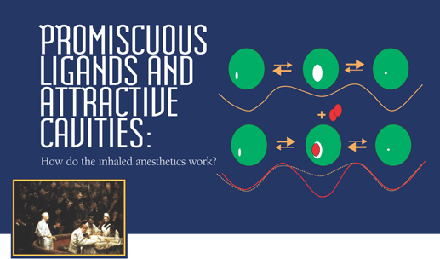PROMISCUOUS LIGANDS AND ATTRACTIVE CAVITIES
How do the inhaled anesthetics work?
Abstract
The inhaled anesthetics were officially introduced to American medicine more than 160 years ago and rank among the most important medical advances in our time. These drugs are used to render patients insensible over twenty million times each year and are the most dangerous of all drugs that physicians currently use. An entire medical specialty, anesthesiology, has arisen out of the need for the special training to administer them safely. Nevertheless, side effects, toxicity, and long-term cognitive problems continue to plague their use, especially in the very sick or aged. Hence, it is essential that we develop an understanding of their molecular pharmacology so that safer alternatives can be developed.

The scene depicted in Thomas Eakins' Agnew Clinic (see cover also) typifies surgery of the 1880s. An anesthetist delivers
diethyl ether from a can in his right hand and a paper cone over the patient's face. The enduring requirement for a burly
assistant to keep the patient from moving emphasizes the uncertain nature of anesthesia even at this advanced point in time.
Over 100 years after the scene was painted, a molecular understanding of anesthesia is far from complete. This Review discusses
some of the provocative concepts that inform current debates about anesthesia. [Agnew Clinic appears courtesy of the University
of Pennsylvania Art Collection, Philadelphia, Pennsylvania.]
- © American Society for Pharmacology and Experimental Theraputics 2001



